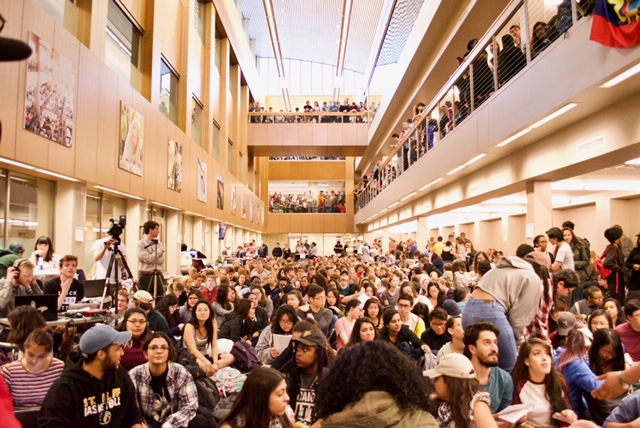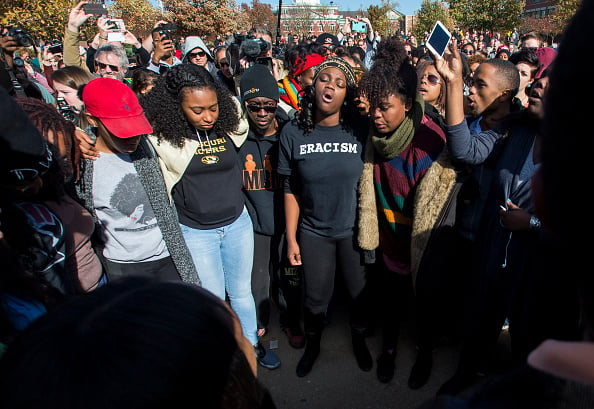You have /5 articles left.
Sign up for a free account or log in.
Student activists' biggest opponent often is the rhythm of college itself. The traditional academic calendar, with built-in holiday breaks, busy finals schedule and months-long summer leaves little uninterrupted time for organizing. And students’ temporary stay on campus all but guarantees setbacks when student leaders graduate.
The calendar dictates a rise and fall of momentum behind student movements. Chris Gannon, vice president for the United States Student Association, a national student organizing group, calls it the “student energy cycle.”
“When you get students coming in the fall, they have more time, they haven’t started their exams and they get really fired up in September and October,” Gannon said. “In November and December, students might not be doing as well in their classes and have to focus on that. They start to lose interest.”
The cycle repeats in the spring when classes resume. Angus Johnston, a history professor at Hostos Community College of the City University of New York, who writes about student activism, said that students are typically more successful in the spring because they laid the groundwork for their organizing in the fall.
Summer break serves as a “reset” button, as seasoned student leaders graduate while underclassmen leave campus. It also gives administrators an opportunity to regroup after protests and demonstrations.
“The summer winds up being the biggest opportunity that the administration will have to undo [students’] work that year, or put in place policies that will have greater student opposition,” Johnston said.
Gannon’s passion for student organizing grew out of a conflict at Wayne State University, where he was an undergraduate. In June 2013, the university approved an 8.9 percent tuition hike as part of its budget for the next year, despite a 3.75 percent statewide tuition increase cap.
“I remember hearing over the summer how mad folks were,” Gannon said, “but they did it at a time that by the time students came back, it would have been three months or so since [the university] voted on it -- maybe the [anger] would have died down.”
Although board meetings and budget votes often occur when students are off campus, it’s not clear how often administrators use the academic calendar to stymie student protest.
“I’m sure there are some places that use the calendar to that effect,” said Kevin Kruger, president of NASPA: Student Affairs Administrators in Higher Education, a national organization for student affairs administrators. “How Machiavellian colleges are about it, I don’t know.”
Protesting, organizing and standing up for one’s beliefs are all parts of a well-rounded education, according to Kruger.
“We think encouraging [activism] is a good thing, even when it's uncomfortable. Subverting that is not the first instinct of student affairs folks,” he said. “Having said that, protests can be unpleasant for a campus when the protest is about the institution itself.”
Institutional Memory
Overcoming challenges posed by the academic calendar can be tough, and students face other disadvantages.
“It’s hard for students because they’re oftentimes full-time students and they’re working a part-time job on the side, which makes their responsibilities add up to more than full-time between the two,” Gannon said. “Organizing is almost like another part-time job.”
It’s unlikely that student leaders will create lasting institutional change during their four years on campus, Johnston said. But by passing on information about their successes and failures to younger students, activists develop the institutional memory required for real progress.
“One of the things that I’ve seen over decades in terms of where students win real victories that are lasting and sustainable, is often you have student institutions that provide you with institutional memory,” Johnston said.
Creating a place for that information to live is crucial. Without it, college officials can wait out student movements knowing that when a new crop of students arrives, they’ll have to start from scratch.
“Students are usually only on campus for four years, so they come in as a freshman and maybe don’t identify issues that they want to organize around until the end of their sophomore year,” Gannon said. “I think administrators use it to their advantage, because I think that they know they’re only going to be seeing the same student protesters for a few more years.”

Four years later, a new group of students convened the Collective for Change on the Hill after a separate series of racist hate incidents (one of the seven reported incidents was later discovered to be a hoax). The movements were similar, as were the racist incidents, but the progress made by Enough! was lost before the collective could build on it.
Neither Enough! nor the collective had an institutional “home” at St. Olaf, which Kruger believes is necessary for student activism to outlast student turnover.
“If that activism is contained or sponsored by existing structures at the institution, say, the student government association … or student groups … there are places and opportunities for advisers of those groups to help students form institutional memory,” Kruger said. “I think it’s difficult when the protest is organic and doesn’t have an organizational home.”
‘Us vs. Them’
Erin Hennessy is often called in to help colleges communicate with students, staff and alumni when protests pop up on campus. A critical misstep, said Hennessy, vice president of TVP Communications, is making an enemy of the students.
“One of the things that we see often with some institutions is the instant that there is a protest or a list of demands, there are some administrators who always go on this ‘us vs. them’ footing,” she said. “And it’s amazing how quickly institutions can forget the ‘them’ in the ‘us vs. them’ is their students.”
Protests that escalate into power struggles between the college and the students are the ones that become “bigger, newsier events,” Hennessy said. For example, the ongoing saga of Silent Sam protests at the University of North Carolina at Chapel Hill garnered media attention for months as the campus became a battleground with increased police presence, student arrests and virtually no compromise between students and university leadership. Likewise, when students occupied the administrative offices at Seton Hall University last fall, university officials moved to a building with increased security. A video also revealed a yelling match between a professor and a group of students.
Protests don’t have to lead to war. Hennessy remembered one at Lebanon Valley College in 2015, when students issued a list of demands that called for wide-ranging institutional reform, including hires of more minority faculty members, gender-neutral restrooms and expanded support for LGBT students.
The activists also demanded a renaming of Lynch Memorial Hall, an academic building named for Clyde A. Lynch, a former Lebanon Valley president. Lynch had never been associated with racist violence, but students didn’t want the word “lynch” on campus.
“Administrators approached the students and said, ‘We don’t think that keeping this on the list of the demands you have is going to be beneficial to you, let’s take that off,’” Hennessy said. “It ended up being resolved pretty successfully.”
Post-Missouri Organizing
Student activism in the late 20th century was marked by grassroots organizing and multicollege student associations. Students rallied around workers' rights, environmental justice, antiwar efforts or civil rights. Today’s students often are focused on equity issues, especially those concerning race, and re-examining the power structures in place at colleges.
The 2015 protests at the University of Missouri have become iconic; few talk about campus organizing without mentioning Mizzou.
 “That was a situation where students really were able to leverage power in a very different way,” Johnston said. “And at a moment when the movement against racism on campus and off had been building for some time, Missouri was a flashpoint.”
“That was a situation where students really were able to leverage power in a very different way,” Johnston said. “And at a moment when the movement against racism on campus and off had been building for some time, Missouri was a flashpoint.”
The protest's success was due in part to the support of the Mizzou football team, which held significant leverage over university leadership. At institutions where sports are a vital source of revenue, public support from student athletes, coaches and boosters can move the needle in student activists' favor.
Last month at UNC, more than 280 student athletes signed an open letter condemning the university's decision to construct a $5.3 million building to house the controversial Silent Sam statue, and Roy Williams, UNC's men's basketball coach, sided with the students. UNC's governing board later voted against the project. Relative to past events, the mid-December vote was met with little on-campus protest, likely due to the fact students were in the middle of finals. While it's not clear if the pressure from student athletes influenced the vote, their condemnation received significant media attention in the days leading up to the board meeting.
The endorsement of star athletes is a valuable bargaining chip, but before the football team signed on to back the student cause at Mizzou, protest leaders already had drummed up support with social media and a strong list of demands.
Social media allows students to project their message far beyond campus. And many student movements have their own Facebook, Instagram and Twitter accounts (see the Twitter pages of @shu_concerned44, @uopindecline, @move_silent_sam, @CS_1950).
The pages archive a timeline of actions, contributing further to institutional memory, and help keep students connected and energized when they’re off campus.
“I’d be interested to see if there are revisions to the student energy cycle, because a lot of these students are becoming much savvier about activism,” Hennessy said. “Social media has changed the game in terms of how we all look at calendars and breaks and whether or not breaks will put an end to an issue.”
A revolt at the University of Virginia in 2012 is an early example of this. Over that summer, when the board tried to force out then president Teresa Sullivan (only to reinstate her 18 days later), students joined faculty and alumni in their protests against the decision.
Lists of demands are becoming increasingly popular. Because they are formally written and typically provide guidelines for negotiations with and responses from college officials, they serve as a strong form of institutional memory. Ted Thornhill, a sociology professor at Florida Gulf Coast University, has watched protests -- especially around institutional racism -- unfold everywhere he's taught. Thornhill implores college officials to take the lists seriously.
“Students have put a lot of effort and thought into crafting these demands, and they ought to take them seriously,” he said. “There’s a unifying theme about these lists of demands. It’s not about these places issuing strong statements of condemnation when there are anti-black, anti-Latinx or anti-Muslim hate crimes on campus. That’s not what they’re focused on. These student protesters want substantive changes that will disrupt the white racist architecture that ordains the predominantly white institutions across the country.”
Administrators are often hesitant to take action on the demands, partly due to the fact that students don’t always understand what college officials can and cannot change. Changing processes of faculty hiring, college investments, tuition prices and other areas of interest require input from many stakeholders, not just the college president.
“The challenge with student activists is they often don’t understand what goes into running an academic institution behind the scenes,” Hennessy said. “It just doesn’t work like that. I can’t just say, ‘Here’s the funding for six [faculty] lines and I’m going to overrule the hiring process to get six faculty members in these departments.’”
Even if students don’t present a flawless plan of action, Thornhill hopes administrators pay attention to the students’ underlying concerns and commit to working toward the changes students are asking for.
“I think these administrators are looking at things the wrong way … they’re focused solely on the [immediate] negative consequences of doing the antiracist thing. They seem to be singularly focused on declining applications, declining enrollment, declining donations, declining alumni giving, negative perceptions in the media,” he said. “When these are predominately white institutions, their concerns about the negative consequences are because white folks in those groups have been upset or discomforted.”
Mizzou felt the negative consequences. In the wake of the protests, media coverage painted the campus as divided and unruly. Enrollments plummeted, leading to a decline in revenue and subsequent budget cuts. The administration weathered a wave of resignations, including those of Tim Wolfe, the former university system president, and R. Bowen Loftin, the former Mizzou chancellor.
But over time, antiracist efforts can yield positive results, including helpful attention from members of the news media as well as donors and potential students who appreciate the work and want to contribute to it. “It means you’re going to get other types of students over time,” Thornhill said.
The university has gotten started on several student-requested initiatives, including an effort to hire more minority faculty and staff, recruit more minority students, and prioritize access to mental health services.
Despite its now historic status, the Mizzou protests are not immune to the rhythms of student activism. The Class of 2019, the last group of students who were present for the protests, will graduate in the spring, and time will tell if the students' efforts will outlast their departure.




